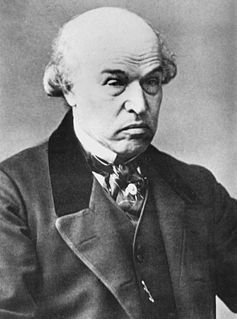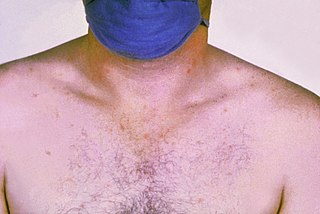
Epidemic typhus is a form of typhus so named because the disease often causes epidemics following wars and natural disasters. The causative organism is Rickettsia prowazekii, transmitted by the human body louse.

Mary Mallon, also known as Typhoid Mary, was an Irish cook. She was the first person in the United States identified as an asymptomatic carrier of the pathogen associated with typhoid fever. She was presumed to have infected 51 people, three of whom died, over the course of her career as a cook. She was twice forcibly isolated by public health authorities and died after a total of nearly three decades in isolation.

Psittacosis—also known as parrot fever, and ornithosis—is a zoonotic infectious disease in humans caused by a bacterium called Chlamydophila psittaci and contracted from infected parrots, such as macaws, cockatiels, and budgerigars, and from pigeons, sparrows, ducks, hens, gulls and many other species of birds. The incidence of infection in canaries and finches is believed to be lower than in psittacine birds.
This is a timeline of the development of prophylactic human vaccines. Early vaccines may be listed by the first year of development or testing, but later entries usually show the year the vaccine finished trials and became available on the market. Although vaccines exist for the diseases listed below, only smallpox has been eliminated worldwide. The other vaccine-preventable illnesses continue to cause millions of deaths each year. Currently, polio and measles are the targets of active worldwide eradication campaigns.

Sir William Jenner, 1st Baronet, GCB, QHP, FRCP, FRS was a significant English physician primarily known for having discovered the distinction between typhus and typhoid.
The UK statutory notification system for infectious diseases is a system whereby doctors are required to notify a "Proper Officer" of the local authority if they are presented with a case of a serious infectious disease such as diphtheria or measles. The Proper Officer then sends a report to the Centre for Infections of the Health Protection Agency (HPA) in Colindale, north London.

Rethel is a commune in the Ardennes department in northern France. It is a sub-prefecture and third-most important city and economic center in the department. It is situated on the river Aisne, near the northern border of Champagne and 37 km from Reims.

The Plague of Athens was an epidemic that devastated the city-state of Athens in ancient Greece during the second year of the Peloponnesian War when an Athenian victory still seemed within reach. It is believed to have entered Athens through Piraeus, the city's port and sole source of food and supplies. Much of the eastern Mediterranean also saw outbreak of the disease, albeit with less impact. The plague returned twice more, in 429 BC and in the winter of 427/426 BC. Some 30 pathogens have been suggested as causing the plague.
ICD-10 is an international statistical classification used in health care and related industries.
A spotted fever is a type of tick-borne disease which presents on the skin. They are all caused by bacteria of the genus Rickettsia. Typhus is a group of similar diseases also caused by Rickettsia bacteria, but spotted fevers and typhus are different clinical entities.

Karl Joseph Eberth was a German pathologist and bacteriologist who was a native of Würzburg.

Heinrich Curschmann was a German internist who was a native of Giessen.

Hélène Sparrow was a pioneer in world public health, a medical doctor and microbiologist. She was noted for her work to control typhus in Poland after the First World War and then leading national programmes of vaccination against diphtheria, scarlet fever, spotted fever and relapsing fever in Poland and Tunisia into the 1960s.

Ernst Brand was a German physician, known for his development of hydrotherapy in the treatment of typhoid fever.
This is a Timeline of typhoid fever, describing major events such as scientific/medical developments and notable epidemics.

Continuous fever is a type or pattern of fever in which temperature does not touch the baseline and remains above normal throughout the day. The variation between maximum and minimum temperature in 24 hours is less than 1°C (1.5°F). It usually occurs due to some infectious disease. Diagnosis of continuous fever is usually based on the clinical signs and symptoms but some biological tests, chest X-ray and CT scan are also used. Typhoid fever is an example of continuous fever and it shows a characteristic step-ladder pattern, a step-wise increase in temperature with a high plateau.
This page is based on this
Wikipedia article Text is available under the
CC BY-SA 4.0 license; additional terms may apply.
Images, videos and audio are available under their respective licenses.












